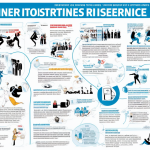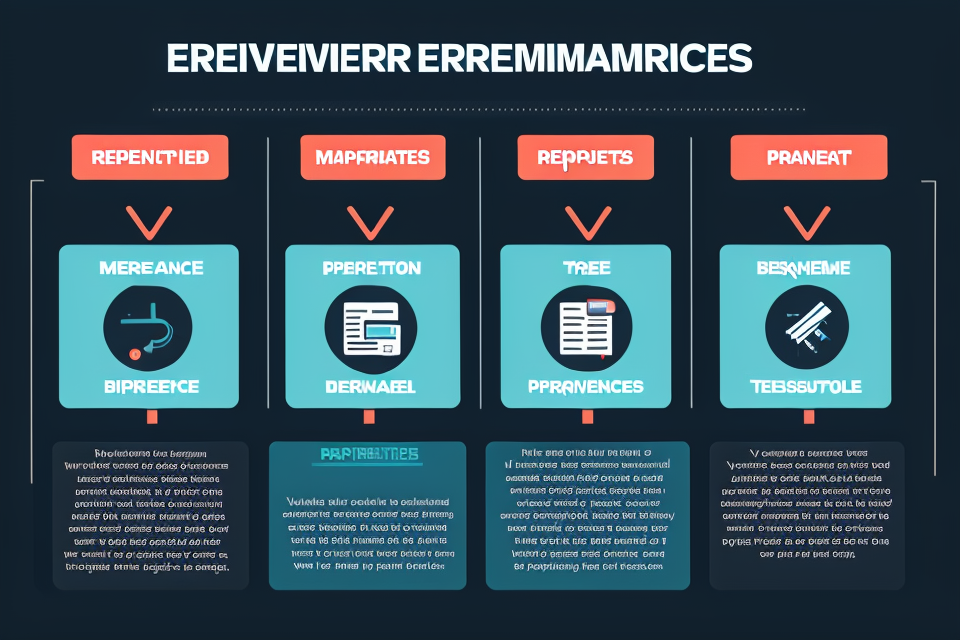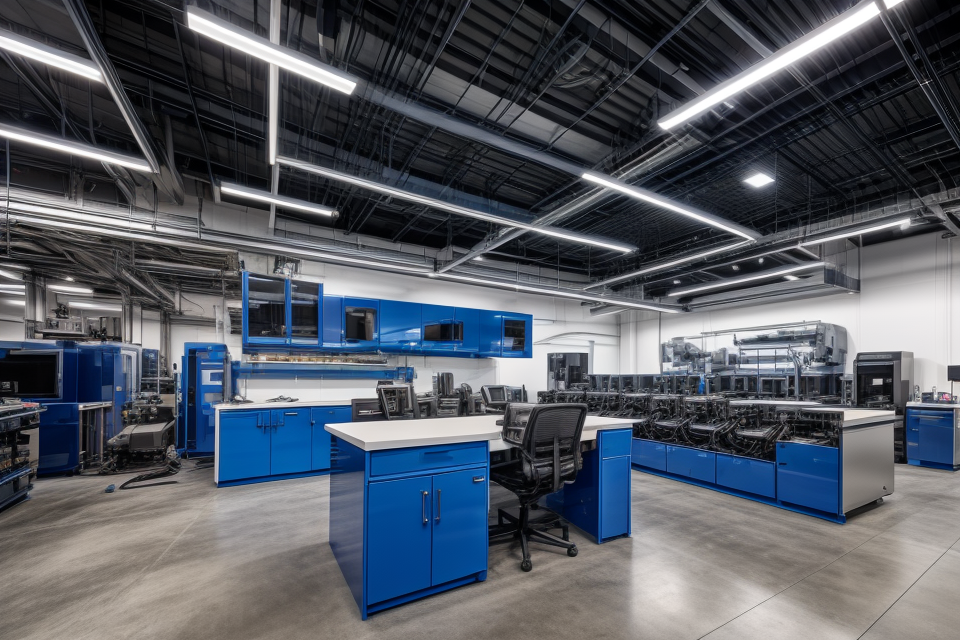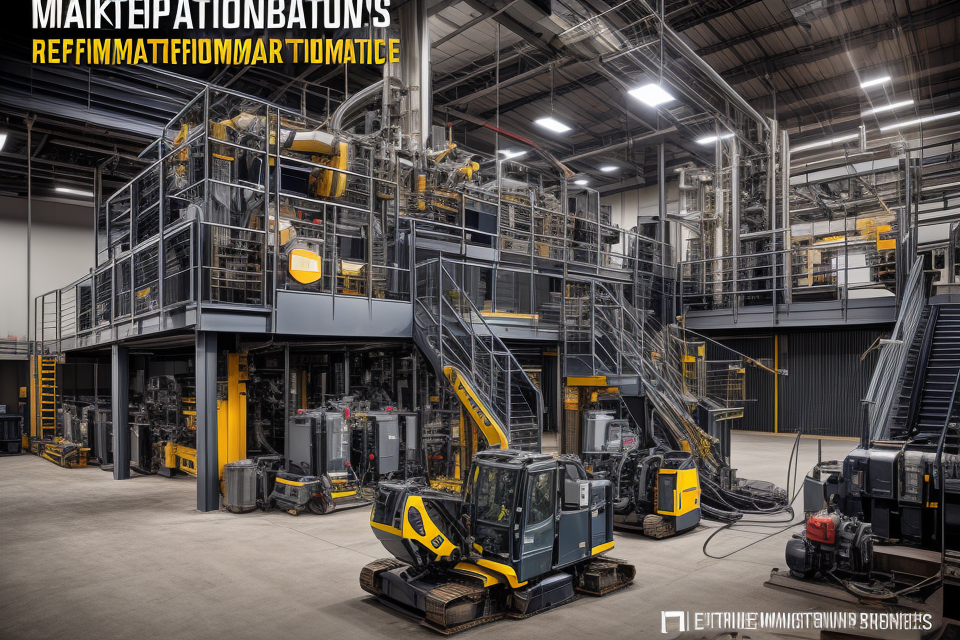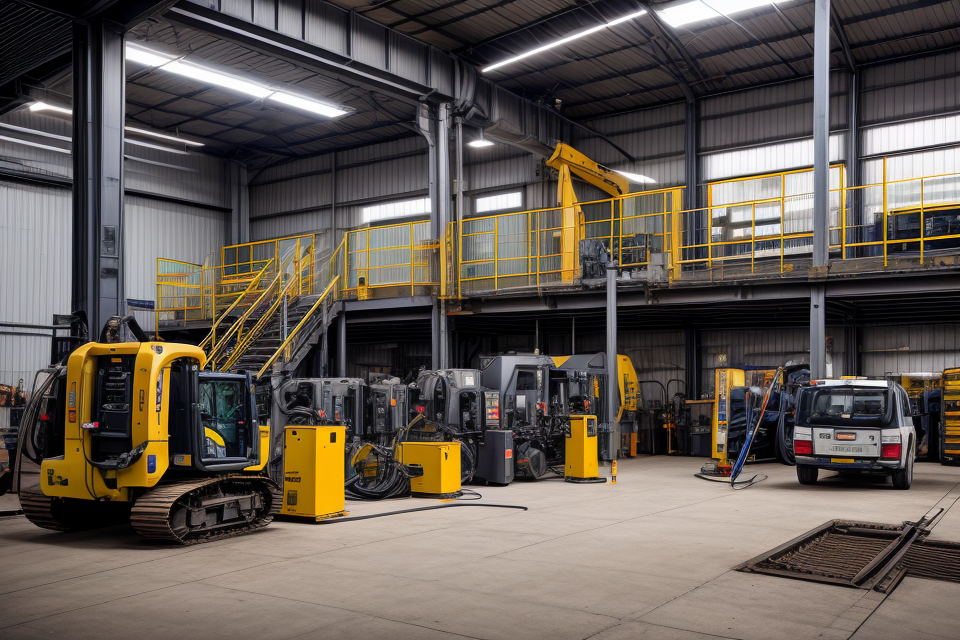Equipment maintenance is an essential aspect of any business that relies on machinery to operate. Proper maintenance ensures that equipment runs smoothly, efficiently, and safely. However, not all maintenance methods are created equal. In fact, there are three distinct types of equipment maintenance, each with its own unique approach and benefits. These types include preventive maintenance, predictive maintenance, and corrective maintenance. Understanding the differences between these maintenance approaches can help businesses optimize their equipment maintenance strategies and reduce downtime, ultimately leading to increased productivity and profitability. In this article, we will explore each type of equipment maintenance in more detail, including their definitions, differences, and best practices. So, let’s dive in and discover how these maintenance approaches can help your business thrive!
Equipment maintenance can be broadly categorized into three types: preventive maintenance, predictive maintenance, and corrective maintenance. Preventive maintenance involves regularly scheduled tasks aimed at preventing equipment failure and extending equipment life. This type of maintenance is typically performed on a regular basis, such as cleaning or lubricating equipment. Predictive maintenance uses data analysis and machine learning algorithms to predict when equipment is likely to fail, allowing maintenance to be performed before a failure occurs. Corrective maintenance is performed after equipment has failed, and involves repairing or replacing the failed component. Each type of maintenance has its own unique benefits and drawbacks, and the appropriate type of maintenance will depend on the specific equipment and its operating environment.
Types of Equipment Maintenance
Preventive Maintenance
Definition
Preventive maintenance is a type of equipment maintenance that involves regular inspection, cleaning, and repair of equipment to prevent future breakdowns.
Importance
Preventive maintenance is important because it helps to reduce downtime, extend the lifespan of equipment, and prevent costly repairs in the future. By identifying potential issues before they become serious problems, preventive maintenance can help businesses avoid unexpected breakdowns and lost productivity.
Techniques
There are several techniques used in preventive maintenance, including regular inspections, lubrication, cleaning, and replacement of worn parts. Some businesses may also use predictive maintenance techniques, such as vibration analysis or thermal imaging, to identify potential issues before they become serious problems.
Benefits
The benefits of preventive maintenance include reduced downtime, extended equipment lifespan, and lower repair costs. By regularly maintaining equipment, businesses can also improve safety and reduce the risk of accidents. In addition, preventive maintenance can help businesses identify opportunities for process improvement, leading to increased efficiency and productivity.
Corrective Maintenance
Corrective maintenance is a type of equipment maintenance that is performed when a piece of equipment has already failed or is not functioning as it should. The primary goal of corrective maintenance is to identify and fix the problem as quickly as possible to minimize downtime and get the equipment back into operation.
Definition
Corrective maintenance is the process of repairing or replacing equipment components that have failed or are not working properly. It is often reactive in nature, as it is performed after a problem has occurred.
Importance
Corrective maintenance is critical for ensuring that equipment is functioning properly and meeting production goals. Without prompt and effective corrective maintenance, equipment failures can lead to extended downtime, lost productivity, and increased costs.
Techniques
The techniques used in corrective maintenance depend on the type of equipment and the nature of the problem. Some common techniques include:
- Repairing or replacing faulty components
- Cleaning or lubricating moving parts
- Adjusting or replacing worn parts
- Calibrating or repairing electronic or electrical systems
Benefits
The benefits of corrective maintenance include:
- Reducing downtime and lost productivity
- Extending the life of equipment
- Improving equipment performance and efficiency
- Minimizing repair costs by catching problems early
- Ensuring compliance with safety regulations and standards.
Predictive Maintenance
Predictive maintenance is a type of equipment maintenance that uses data and analytics to predict when a piece of equipment is likely to fail. This type of maintenance is becoming increasingly popular in many industries because it can help to reduce downtime and extend the lifespan of equipment.
Predictive maintenance is a proactive approach to equipment maintenance that uses data to identify potential issues before they become serious problems. It involves collecting data from various sources, such as sensors and performance indicators, and analyzing it to identify patterns and trends. This data is then used to predict when a piece of equipment is likely to fail, allowing maintenance teams to take preventative measures before a failure occurs.
Predictive maintenance is important because it can help to reduce downtime and extend the lifespan of equipment. By identifying potential issues before they become serious problems, maintenance teams can take preventative measures to avoid costly repairs and downtime. This can help to improve productivity and efficiency, as well as reduce the risk of equipment failure.
There are several techniques that are used in predictive maintenance, including:
- Condition monitoring: This involves collecting data from sensors and performance indicators to monitor the condition of a piece of equipment.
- Predictive modeling: This involves using statistical and mathematical models to predict when a piece of equipment is likely to fail.
- Failure mode and effects analysis (FMEA): This involves identifying potential failure modes and their effects on the equipment and the system as a whole.
The benefits of predictive maintenance include:
- Reduced downtime: By identifying potential issues before they become serious problems, maintenance teams can take preventative measures to avoid downtime.
- Extended equipment lifespan: Predictive maintenance can help to extend the lifespan of equipment by identifying potential issues before they cause serious damage.
- Improved productivity: By reducing downtime and improving equipment performance, predictive maintenance can help to improve productivity and efficiency.
- Cost savings: By reducing downtime and extending the lifespan of equipment, predictive maintenance can help to reduce costs associated with repairs and replacements.
Scheduled Maintenance
Definition:
Scheduled maintenance refers to the planned and regular maintenance activities that are performed on equipment at specific intervals or according to a predetermined schedule. It involves carrying out maintenance tasks on a regular basis to ensure that equipment remains in good working condition and to prevent breakdowns or equipment failure.
Importance:
Scheduled maintenance is critical to the proper functioning of equipment and the smooth operation of business processes. It helps to identify potential problems before they become serious and can result in costly downtime or equipment failure. By regularly maintaining equipment, businesses can avoid unexpected breakdowns, extend the life of their equipment, and improve their overall productivity.
Techniques:
Scheduled maintenance can be carried out using various techniques, including:
- Regular inspections: Regular inspections are performed to identify any potential problems with equipment and to ensure that it is in good working condition.
- Preventive maintenance: Preventive maintenance involves performing routine maintenance tasks on equipment to prevent problems from occurring in the first place.
- Condition-based maintenance: Condition-based maintenance involves monitoring the performance of equipment and carrying out maintenance tasks only when necessary, based on the equipment’s condition.
Benefits:
The benefits of scheduled maintenance include:
- Increased equipment reliability: Regular maintenance helps to ensure that equipment remains in good working condition, reducing the risk of breakdowns or equipment failure.
- Reduced downtime: By identifying potential problems before they become serious, scheduled maintenance can help to reduce downtime and improve overall productivity.
- Cost savings: Regular maintenance can help to extend the life of equipment, reducing the need for costly repairs or replacements and saving money in the long run.
Overall, scheduled maintenance is an essential aspect of equipment maintenance and is critical to the proper functioning of equipment and the smooth operation of business processes. By regularly maintaining equipment, businesses can avoid unexpected breakdowns, extend the life of their equipment, and improve their overall productivity.
Condition-Based Maintenance
Condition-based maintenance (CBM) is a type of maintenance strategy that is performed when equipment conditions reach a predetermined threshold. The decision to perform maintenance is based on the current and predicted condition of the equipment. This approach aims to maximize equipment uptime while minimizing maintenance costs.
CBM is crucial in improving equipment reliability and availability. By scheduling maintenance based on equipment conditions, it is possible to reduce unplanned downtime, extend equipment life, and minimize repair costs. This approach is particularly useful in industries where equipment failure can have significant consequences, such as in the aerospace, defense, and nuclear power sectors.
CBM techniques involve monitoring equipment conditions through various means, such as vibration analysis, thermal imaging, and ultrasonic testing. Data collected from these techniques is used to determine when maintenance should be performed. Predictive maintenance models are also used to forecast when maintenance will be required based on historical data and current conditions.
The benefits of CBM include:
- Increased equipment uptime
- Reduced maintenance costs
- Extended equipment life
- Improved safety
- Enhanced productivity
- Better resource allocation
In summary, condition-based maintenance is a proactive maintenance strategy that is based on the current and predicted condition of equipment. It involves monitoring equipment conditions through various means and performing maintenance when conditions reach a predetermined threshold. CBM is crucial in improving equipment reliability and availability, reducing maintenance costs, and enhancing safety.
Reactive Maintenance
Reactive maintenance refers to the maintenance approach where repairs are carried out only after a failure or breakdown of equipment has occurred. It is a reactive response to a problem rather than a proactive one.
Reactive maintenance is essential in situations where immediate repairs are required to prevent equipment downtime, production losses, and safety hazards. It helps to minimize the impact of unexpected equipment failures on the business operations.
Some of the techniques used in reactive maintenance include:
- Emergency repairs: Repairs carried out in response to a sudden equipment failure or breakdown.
- Troubleshooting: Identifying and fixing the cause of the equipment failure.
- Root cause analysis: Identifying the underlying cause of the equipment failure to prevent future occurrences.
Some of the benefits of reactive maintenance include:
- Minimizing equipment downtime: Repairs are carried out only when necessary, reducing the impact of equipment failures on business operations.
- Cost-effective: Repairs are carried out only when necessary, reducing the costs associated with unnecessary maintenance.
- Increased safety: Repairs are carried out promptly, reducing the risk of safety hazards associated with equipment failures.
Overall, reactive maintenance is an essential maintenance approach in situations where immediate repairs are required to prevent equipment downtime, production losses, and safety hazards. While it may be more costly than preventive maintenance, it helps to minimize the impact of unexpected equipment failures on business operations.
Emergency Maintenance
Emergency maintenance refers to the immediate attention given to equipment failures or breakdowns that pose a significant risk to equipment functionality, safety, or production. This type of maintenance is performed when an unplanned equipment failure occurs, and it aims to restore equipment operations to normal as quickly as possible.
Emergency maintenance is critical in preventing equipment downtime, which can be costly for businesses. In addition, it helps to ensure the safety of workers and equipment, minimize the risk of equipment damage, and maintain production schedules. Emergency maintenance is often performed during regular business hours, and it requires a rapid response from maintenance personnel.
The techniques used in emergency maintenance depend on the type of equipment and the nature of the failure. Some common techniques include troubleshooting, repair, replacement of parts, and cleaning. Emergency maintenance may also involve the use of emergency spare parts or equipment to minimize downtime.
The benefits of emergency maintenance include the restoration of equipment functionality, minimization of downtime, prevention of equipment damage, and ensuring the safety of workers and equipment. It also helps to maintain production schedules and avoid delays in delivery. By performing emergency maintenance promptly, businesses can avoid costly repairs and replacement of equipment, which can be more expensive in the long run.
Factors to Consider When Choosing a Maintenance Type
Equipment Type
When choosing a maintenance type for equipment, the type of equipment being maintained is an important factor to consider. Different types of equipment require different maintenance strategies due to their unique characteristics and requirements. Some examples of equipment types and their corresponding maintenance types include:
- Production equipment: Production equipment, such as machinery and assembly lines, require preventive maintenance to ensure that they continue to operate at peak efficiency. This type of equipment is critical to the production process and any downtime can result in significant losses.
- Office equipment: Office equipment, such as computers, printers, and copiers, require corrective maintenance to address issues that arise during operation. This type of equipment is used for support functions and downtime is less critical than in production equipment.
- Building systems: Building systems, such as HVAC, plumbing, and electrical systems, require both preventive and corrective maintenance to ensure that they continue to function properly. This type of equipment is critical to the safety and comfort of building occupants and any issues can have significant consequences.
In addition to the type of equipment, other factors such as the cost of maintenance, the availability of skilled technicians, and the level of risk associated with equipment failure should also be considered when choosing a maintenance type.
Operating Environment
The operating environment of the equipment is a crucial factor to consider when choosing a maintenance type. This refers to the conditions in which the equipment is used, such as temperature, humidity, and exposure to chemicals or other hazardous materials. For example, if the equipment is used in a highly corrosive environment, it may require more frequent preventive maintenance to prevent damage to the equipment.
In addition, the operating environment can also impact the type of maintenance required for the equipment. For instance, if the equipment is used in a high-temperature environment, it may require more frequent lubrication and cooling system maintenance to prevent overheating and prolong the equipment’s lifespan.
Moreover, the operating environment can also affect the frequency of equipment breakdowns and the severity of the consequences. For example, if the equipment is used in a hazardous environment, such as a chemical plant, equipment failures can have serious consequences and may require immediate attention from maintenance personnel. In such cases, it may be necessary to have a more comprehensive maintenance plan in place to minimize the risk of equipment failure.
Therefore, it is important to carefully consider the operating environment when choosing a maintenance type for equipment. This will help ensure that the equipment is properly maintained and can operate at peak performance, while also minimizing the risk of equipment failure and its potential consequences.
Cost
When it comes to equipment maintenance, cost is a crucial factor to consider. There are different types of maintenance, each with its own cost implications. Here’s a closer look at the cost aspects of the three types of equipment maintenance:
- Preventive Maintenance: Preventive maintenance is the most cost-effective type of maintenance. It involves regular inspections, cleaning, and repairs to prevent equipment breakdowns. By implementing a preventive maintenance program, businesses can save money by reducing the frequency of major repairs and extending the life of their equipment. Preventive maintenance costs can include labor, materials, and equipment upgrades.
- Predictive Maintenance: Predictive maintenance uses data analysis and machine learning algorithms to predict when equipment is likely to fail. This type of maintenance can be more expensive than preventive maintenance, as it requires specialized software and expertise. However, predictive maintenance can help businesses avoid costly unplanned downtime and extend the life of their equipment, making it a worthwhile investment in the long run. Predictive maintenance costs can include software licenses, data analysis services, and specialized training.
- Reactive Maintenance: Reactive maintenance is the most expensive type of maintenance. It involves repairing equipment after it has already broken down. This type of maintenance can be costly as it often requires emergency repairs, which can be time-consuming and expensive. Reactive maintenance costs can include labor, materials, and emergency services.
In conclusion, the cost of equipment maintenance depends on the type of maintenance being implemented. Preventive maintenance is the most cost-effective option, while reactive maintenance is the most expensive. Businesses should carefully consider their maintenance options and weigh the costs and benefits of each type to determine the best approach for their specific needs.
Availability of Resources
When choosing a maintenance type for equipment, one important factor to consider is the availability of resources. This includes not only financial resources, but also the availability of personnel, tools, and spare parts.
- Financial Resources: Different maintenance types require different levels of financial investment. For example, preventive maintenance may require a higher initial investment in tools and equipment, while corrective maintenance may require more frequent expenditures on spare parts.
- Personnel: The availability of skilled personnel is crucial for some maintenance types. For instance, condition-based maintenance may require specialized knowledge and training to properly diagnose and repair equipment.
- Tools and Spare Parts: The availability of tools and spare parts is also an important consideration. Some maintenance types, such as predictive maintenance, may require specialized tools that are not readily available. Additionally, the availability of spare parts can impact the timeliness and cost of repairs.
In conclusion, the availability of resources is an important factor to consider when choosing a maintenance type. It is important to carefully assess the financial, personnel, and tool requirements of each maintenance type to ensure that they are feasible and can be effectively implemented.
Equipment Criticality
When choosing a maintenance type for equipment, one crucial factor to consider is the equipment’s criticality. This refers to the importance of the equipment to the organization’s operations and its impact on business continuity. Essentially, it is about determining the extent to which the equipment’s downtime or failure would affect the organization’s ability to meet its goals and objectives.
There are several ways to determine equipment criticality, including:
- The impact of the equipment on production or service delivery
- The financial value of the equipment
- The availability of replacement equipment or spare parts
- The ease of repair or replacement of the equipment
- The regulatory or legal requirements related to the equipment
By assessing the equipment’s criticality, organizations can prioritize their maintenance efforts and allocate resources more effectively. For instance, critical equipment may require more frequent and thorough maintenance, while less critical equipment may be able to tolerate more downtime or have a more flexible maintenance schedule.
FAQs
1. What are the three types of equipment maintenance?
Answer:
The three types of equipment maintenance are preventive maintenance, predictive maintenance, and corrective maintenance.
2. What is preventive maintenance?
Preventive maintenance is a type of equipment maintenance that is performed on a regular schedule or at predetermined intervals to prevent equipment failure or breakdown. This type of maintenance includes activities such as cleaning, lubricating, and inspecting equipment.
3. What is predictive maintenance?
Predictive maintenance is a type of equipment maintenance that uses data analysis and machine learning algorithms to predict when equipment is likely to fail. This type of maintenance includes activities such as condition monitoring, vibration analysis, and oil analysis.
4. What is corrective maintenance?
Corrective maintenance is a type of equipment maintenance that is performed after equipment has failed or broken down. This type of maintenance includes activities such as repairing or replacing damaged parts, and restoring equipment to its normal operating condition.
5. How do the three types of equipment maintenance differ?
The three types of equipment maintenance differ in their focus and purpose. Preventive maintenance is performed to prevent equipment failure, predictive maintenance is performed to predict when equipment is likely to fail, and corrective maintenance is performed to repair or replace equipment after it has failed.

